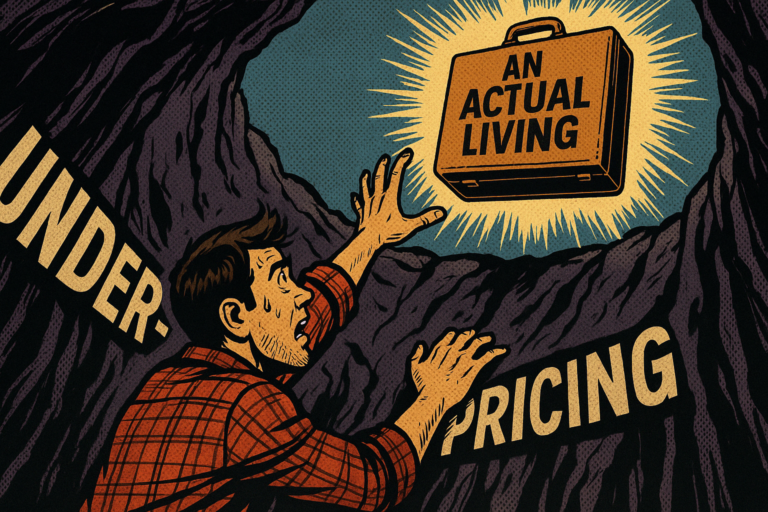I’ve been singing the praises of work-from-home and self-employment flexibility for a while now. In fact, I recently documented a working/vacationy road trip I took with my wife and kids recently.
Benefits vs. Benefits
When you make the jump from working for somebody to working for yourself – you gain a ton of benefits and opportunities – like flexibility. But you also lose some benefits. Or rather, I should say, there are a number of things that are typically provided by an employer that you are now responsible for, like Sick Leave and other Paid Time Off.
Today, I’m going to explain how I navigate this – and you can too – using pricing, processes, and p…. p…. software (I tried). Giving yourself P.T.O. doesn’t have to be a P.I.T.A. In fact, it can help boost your P-R-O-F-I-T-S.
This is part one of a three part series that will cover the “Unholy Trinity of Trepidation” – The 3 main expenses you need to plan for before you begin your self employment journey. In addition to vacation and sick time, other big ticket items you are now on the hook for:
- The employer’s share of Social Security and Medicare taxes
- Health Insurance
There’s plenty more we could add to the list – retirement contribution matching, office supplies, also some intangible benefits that come with a full-time job, like accountability and structure, and having co-workers… which depending where you work you might not think of those things as benefits.
It’s these three things (PTO, Taxes, and Insurance) that I believe are the biggest hurdles a transitioning self-employee will need to jump over. Especially because they all can come with a pretty hefty price tag.
There’s a lot that can be – and will be said for each of these, but we’re going to take it one at a time, and today we’ll dig into Sick Leave (and other PTO).
Now you might be thinking – how big a deal is this really? “I have flexibility now. The time off issue takes care of itself.” Yes, and no. The PTO issue is probably the easiest of the Big 3 to sort out… for some people. But however good or bad you are at time management, I would encourage you to take just a little bit of time to think more intentionally about your time and how to properly value it as a business.
How much paid time off do people typically get?
In the United States, a standard benefits package often includes two weeks of vacation and five sick days. Then there’s federal holidays – I believe there are 11 now. We’re looking at about five weeks off each year.
We’re talking on average. Different companies may offer more, less, nothing at all. Workers usually become eligible for more PTO the longer they’ve been at a company. But let’s run with this 5 week figure. That’s roughly 10% of the year that we don’t have to work – but we still get a steady paycheck. That’s pretty nice!
The freelance world is usually not nearly as steady. Our time is flexible, but so is our paycheck, because our paycheck is usually directly linked with our time. There’s different ways to unlink them and move towards more predictable, recurring income. But that can take time to establish. Right now, there are some short term moves you can make to start building your own benefits package and a solid buffer, so you can safely take a day off without worrying about how it’s going to impact your bottom line.
First things first
Give yourself a 10% raise.
At least 10%. I once heard someone say, “Figure out your hourly rate – then add taxes, retirement savings, health insurance” and I would add vacation and sick leave. The only way we’re going to replace all of these lost benefits is to price them into our services. This is what your old employer did. They priced into the cost of their goods and services all of the overhead required to keep the company running, which included your salary and the assumption that you weren’t going to come into work 10% of the time. It’s only fair that you do the same!
The only way we’re going to replace all of these lost benefits is to price them into our services.
If you’re anything like me 2 years ago squirming in your chair thinking about the prospect of raising prices, Listen up. Some real talk now:
- You’re worth it.
And not just in a fluffy way. Your employer thought you were at least worth your salary. Liquidate the your benefits and add that to your paycheck. Now give yourself a promotion, because you’re not just doing your job anymore – you’re running your own company. You’re the CEO AND the customer service rep AND the custodian. There’s a lot more work you put into running your business than you probably realize; it’s not work you bill for, but it’s work you need to price in. Because it’s all helping you create value for your clients. Charge for it. - This is your livelihood now.
If you don’t set your rates in a way where you can cover your expenses and provide for your family, then this won’t be sustainable. You’ll stress out, you’ll starve, and you’ll get sick from it all…. And you won’t have any sick days, and you’ll be thinking, man, I really wished I had raised my prices. Take this seriously. - That will also help your clients take you seriously.
Don’t be afraid to price yourself as a professional. Because that’s what you are. And it will send a strong signal to prospective clients that you provide a quality service. If you are the cheapest option out there, that’s not necessarily going to attract more customers. That’s going to make people suspicious and assume that you’re priced cheap because you do cheap quality work. And the customers who are into that – who are so price sensitive that they are willing to pay somebody below market value to do a job poorly, they are going to be a headache. That’s all I’ll say about that for now.
At the end of this video I’ll let you know where you can get a lot more great content on pricing theory, but for now let’s move on to the next piece of this puzzle…
Building your benefits package (and then actually using it)
I’m not going to get overly prescriptive with this. There’s lots of different approaches you can take, it depends a lot on how you’re handling your finances in general. If you work with an accountant, you should definitely ask them for input. The key is to intentionally budget your PTO – and everything else for that matter. You don’t just spend all the money you’re making without being sure you have enough to cover all of your expenses, right? Treat your PTO just like you would a software subscription, or office supplies, or other things you spend money on in order to keep your business running.
You can do this with a simple spreadsheet. I would recommend actually setting up a separate bank account. Again, this can play out in a number of ways.
If you’re in the early stages and you’re set up as a sole proprietorship or even a single-member LLC, all of your business income flows directly to you. So you could either save your vacation fund in an account on the business side or on the personal side. It doesn’t really matter. It’s going to be taxed the same. But if you already have a vacation fund in your personal accounts and are using that to save up for airfare, hotels, recreation, etc for when you go on vacation, make sure you keep your PTO fund separate. These are two different things. Your PTO savings allow you to go on vacation and replaces the income you’re not earning while you are sick or away. A personal vacation fund pays for what you do while you’re on break. It’s best not to mingle these two.
If you are an S-Corp you are probably already set up with a payroll process where you draw a fixed amount for your paycheck every two weeks or every month, similar to a traditional employment situation, then you’re mostly set. Just make sure you are keeping a cash reserve – either on your books or in a separate account. So in the event you take in a little less revenue one month and your regular account is starting to dry up, you can open the reserves and keep a steady stream of cash flowing into your pocket and everywhere else it needs to go.
Check out Catch.co. It’s a pretty slick tool that I’ve used in the past. It automates everything we’re talking about right. You can connect your business bank account and have it automatically withdraw a portion of your paycheck into different buckets for taxes, health care, and paid time off. They offer the option to set up an IRA and automate retirement savings, as well as purchase Marketplace health insurance. It’s been a while for me to say whether or not the rates on those products are any good. But the prospect of having everything managed through a central portal is incredibly attractive. They do have some optional paid add-ons for things like automatically sending quarterly estimated payments to the IRS and linking multiple bank accounts. But the core service is free to use. So definitely give it a spin.
I’ve since adjusted my money management situation, so I’m not using it anymore, but I wouldn’t hesitate to recommend Catch to people who are getting started with self-employment and want some help getting their benefits and savings set up.
Now you’re rolling!
Congratulations! You are now on your way to a fully-funded benefits package complete with vacation days and sick leave.
But there’s one more thing you have to do. You have to promise me that you’re actually going to USE it! Seriously, drop a comment down below. I want to hear you say – or read you write – “I’m going to take a break.” Or something, let me know your favorite vacation spot. Give me some tips on where I should take my family this summer.
Yes, you have the self-employment-flexibility superpowers. Yes, you’re scared of all of the other unknowns and are tempted to just let these PTO savings accumulate into a general rainy day emergency fund. You should absolutely be building an emergency fund as well. But don’t mix that up with this. You need to give yourself permission to take a vacation, take a rest, when you’re sick, and when you’re not. It’s good for your health, it’s good for your relationships, it’s good for your soul, your creativity, your productivity, your profitability – there are so many studies about how vacation is better for the bottom line – it’s just GOOD.
And when you do take a day off, pull some money out of the PTO fund and transfer it wherever they need to go – on the personal side, on the business side – that’s all dependent on how you have your money moving around.
These are not rules. This is just a template to show you what is possible and how you can get started. You modify this to work best for you and your financial workflow. But the main thing I want you to take away from this is to 1) Give yourself PTO, and 2) make sure to set your prices appropriately so you can pay for PTO and the other expenses you no longer have covered by an employer.
In future installments, I’ll speak to the two remaining roadblocks to self-employment: taxes and insurance.
At the end of the day, this stuff isn’t very complicated. I’m not sharing any secrets or casting and business wizardry. You probably already know what you need to do, but I get it. It’s a lot. It’s daunting. To stare down the barrel of these liabilities that a Human Resources or Accounting department has typically taken care of for you.
But you can do it. It’s a little money. It’s some online forms. Don’t let these things stand in your way and keep you from doing what you were meant to do. If you need somebody to help walk you through it – please, reach out to me through the contact form or drop a comment below. I would love to hear from you and help you move forward on your Business Hero Journey.
Stay healthy. I’ll see you in the next one.



